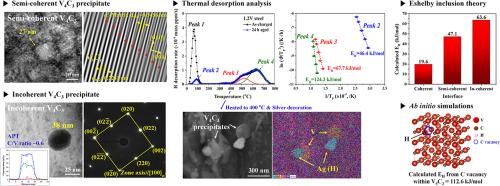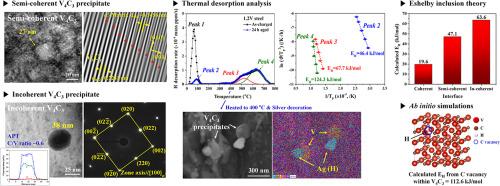Revealing the activation energies for H desorption from spherical semi-coherent and incoherent V4C3 precipitates in martensitic medium-Mn steel
IF 9.3
1区 材料科学
Q1 MATERIALS SCIENCE, MULTIDISCIPLINARY
引用次数: 0
Abstract
We investigated H desorption activation energies (EH) associated with semi-coherent and incoherent V carbides in martensitic medium-Mn steels, as well as the effect of these precipitates on hydrogen embrittlement (HE) resistance. The V-added specimens contained numerous spherical V4C3 precipitates with an average C/V ratio of 0.6. These precipitates exhibited size-dependent interface characteristics: fine precipitates smaller than 30 nm formed semi-coherent interfaces with a misfit strain of 0.07, following the Baker-Nutting orientation relationship, whereas larger precipitates exceeding 30 nm exhibited incoherent interfaces. Thermal desorption analysis (TDA) combined with ab initio simulations identified four distinct H desorption peaks. Peak 1 (75 °C) was associated with coherent V4C3 interfaces and other reversible trap sites. Peak 2 (100 °C, EH = 46.4 kJ/mol) was attributed to H trapped in elastic fields surrounding semi-coherent V4C3 interfaces, while Peak 3 (520 °C, EH = 67.7 kJ/mol) originated from elastic fields around incoherent V4C3 interfaces. Peak 4 (631 °C, EH = 124.3 kJ/mol) corresponds to C vacancies within V4C3 precipitates. Using Oriani’s equilibrium theory applied to a spherical precipitate model considering precipitate volume fraction and H binding energy, the calculated H trapping fraction in incoherent precipitates was approximately twice that in semi-coherent precipitates. This trend is consistent with the TDA results, where the H content associated with Peak 3 was about twice that of Peak 2. The V-added specimens exhibited ductile fracture, whereas the V-free specimen showed brittle fracture, indicating that V4C3 precipitates act as effective H trapping sites and enhance HE resistance in martensitic steel.


揭示了马氏体中锰钢球状半共格和非共格V4C3析出氢的活化能
研究了马氏体中锰钢中半共格和非共格V碳化物的氢解吸活化能(EH),以及这些析出物对抗氢脆(HE)性能的影响。添加V的试样中含有大量球形V4C3析出物,平均C/V比为0.6。这些相具有尺寸依赖的界面特征:小于30 nm的细相形成半共格界面,错配应变为0.07,遵循Baker-Nutting取向关系,而大于30 nm的大相则呈现非共格界面。热解吸分析(TDA)结合从头算模拟确定了四个不同的氢解吸峰。峰1(75°C)与相干V4C3界面和其他可逆陷阱位点有关。峰2(100°C, EH = 46.4 kJ/mol)来自半相干V4C3界面周围弹性场中的H,峰3(520°C, EH = 67.7 kJ/mol)来自非相干V4C3界面周围弹性场。峰4(631℃,EH = 124.3 kJ/mol)对应于V4C3析出物中的C空位。将Oriani平衡理论应用于考虑析出相体积分数和H结合能的球形析出相模型,计算出非相干析出相中的H俘获分数约为半相干析出相的两倍。这一趋势与TDA结果一致,峰3的H含量大约是峰2的两倍。添加v的试样表现为韧性断裂,而不添加v的试样表现为脆性断裂,表明V4C3析出物是有效的H捕获位点,增强了马氏体钢的抗HE能力。
本文章由计算机程序翻译,如有差异,请以英文原文为准。
求助全文
约1分钟内获得全文
求助全文
来源期刊

Acta Materialia
工程技术-材料科学:综合
CiteScore
16.10
自引率
8.50%
发文量
801
审稿时长
53 days
期刊介绍:
Acta Materialia serves as a platform for publishing full-length, original papers and commissioned overviews that contribute to a profound understanding of the correlation between the processing, structure, and properties of inorganic materials. The journal seeks papers with high impact potential or those that significantly propel the field forward. The scope includes the atomic and molecular arrangements, chemical and electronic structures, and microstructure of materials, focusing on their mechanical or functional behavior across all length scales, including nanostructures.
 求助内容:
求助内容: 应助结果提醒方式:
应助结果提醒方式:


